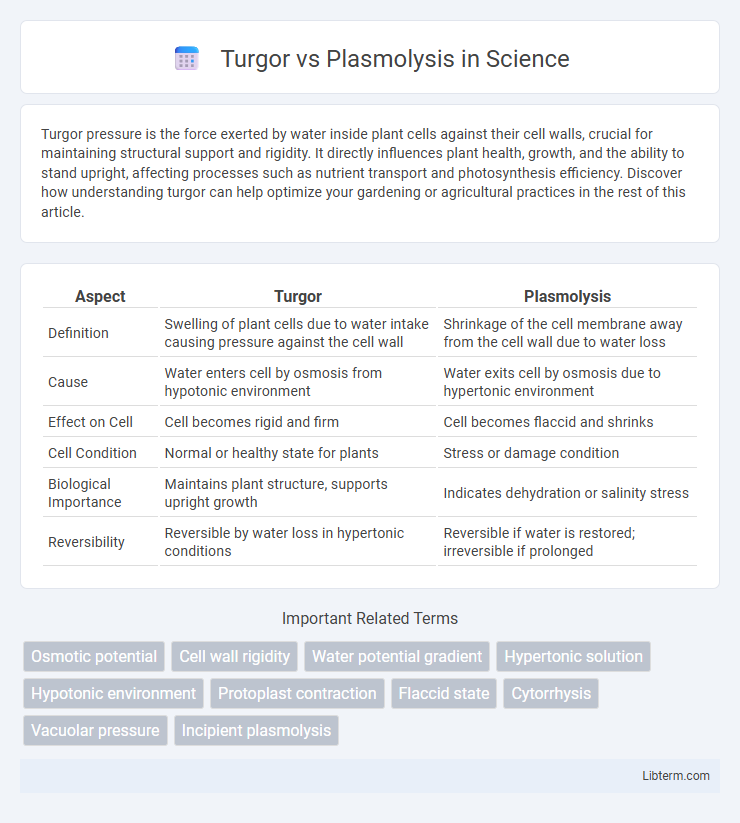Turgor pressure is the force exerted by water inside plant cells against their cell walls, crucial for maintaining structural support and rigidity. It directly influences plant health, growth, and the ability to stand upright, affecting processes such as nutrient transport and photosynthesis efficiency. Discover how understanding turgor can help optimize your gardening or agricultural practices in the rest of this article.
Table of Comparison
| Aspect | Turgor | Plasmolysis |
|---|---|---|
| Definition | Swelling of plant cells due to water intake causing pressure against the cell wall | Shrinkage of the cell membrane away from the cell wall due to water loss |
| Cause | Water enters cell by osmosis from hypotonic environment | Water exits cell by osmosis due to hypertonic environment |
| Effect on Cell | Cell becomes rigid and firm | Cell becomes flaccid and shrinks |
| Cell Condition | Normal or healthy state for plants | Stress or damage condition |
| Biological Importance | Maintains plant structure, supports upright growth | Indicates dehydration or salinity stress |
| Reversibility | Reversible by water loss in hypertonic conditions | Reversible if water is restored; irreversible if prolonged |
Introduction to Turgor and Plasmolysis
Turgor pressure is the force exerted by water inside plant cells against the cell wall, maintaining cell rigidity and structural integrity essential for growth and stability. Plasmolysis occurs when plant cells lose water in a hypertonic environment, causing the plasma membrane to detach from the cell wall, leading to cell shrinkage and loss of turgor pressure. Understanding the balance between turgor and plasmolysis is crucial for studying plant physiology, especially in relation to water uptake, drought stress, and cell osmotic regulation.
What is Turgor Pressure?
Turgor pressure is the force exerted by water inside plant cells against the cell wall, maintaining cell rigidity and structural integrity. This pressure occurs when water enters the cell via osmosis, filling the central vacuole and pushing the plasma membrane outward. Turgor pressure is essential for plant support, growth, and nutrient transport, contrasting with plasmolysis where water loss causes cell shrinkage and membrane detachment from the cell wall.
Understanding Plasmolysis
Plasmolysis occurs when plant cells lose water in a hypertonic solution, causing the cell membrane to detach from the cell wall as the cytoplasm shrinks. This process is critical in understanding osmotic balance and cellular response to water stress in plants. Turgor pressure, in contrast, refers to the force exerted by water inside the cell against the cell wall, maintaining rigidity and structural stability.
Key Differences Between Turgor and Plasmolysis
Turgor pressure occurs when plant cells are fully hydrated, causing the cell membrane to press firmly against the cell wall, which maintains structural rigidity and supports plant tissues. Plasmolysis happens when cells lose water in a hypertonic environment, causing the cell membrane to shrink away from the cell wall, leading to wilting and loss of rigidity. The key differences between turgor and plasmolysis lie in their effects on cell volume, pressure, and overall plant cell health, where turgor supports cellular function and plasmolysis inhibits it.
Role of the Cell Wall in Turgor and Plasmolysis
The cell wall plays a critical role in maintaining turgor pressure by providing structural support that prevents the cell from bursting as water enters. During plasmolysis, the cell membrane detaches from the cell wall due to water loss, but the rigid cell wall retains the cell's shape, preventing collapse. This difference highlights the cell wall's essential function in preserving cellular integrity under varying osmotic conditions.
Effects on Plant Growth and Health
Turgor pressure maintains cell rigidity by ensuring cells remain full of water, which supports plant growth and structural integrity. Plasmolysis occurs when cells lose water in hypertonic environments, causing the plasma membrane to pull away from the cell wall, leading to inhibited growth and potential cell death. Sustained turgor pressure promotes nutrient transport and cell expansion, while plasmolysis disrupts metabolic activities and weakens overall plant health.
Environmental Factors Influencing Turgor and Plasmolysis
Turgor pressure in plant cells is primarily influenced by the availability of water in the soil, temperature, and humidity levels, which affect water uptake and retention within the cell vacuoles. Plasmolysis occurs under hypertonic environmental conditions such as high salinity or drought stress, causing water to exit the cell and the plasma membrane to detach from the cell wall. Soil salinity, ambient temperature, and atmospheric moisture play critical roles in modulating osmotic balance, directly impacting the onset of turgor pressure or plasmolysis in plant cells.
Reversibility: Can Plasmolysis be Reversed?
Plasmolysis is a reversible process where plant cells lose water in hypertonic solutions, causing the cell membrane to pull away from the cell wall. When returned to a hypotonic or isotonic environment, the cell can reabsorb water, restoring turgor pressure and normal cell structure. However, prolonged plasmolysis can cause irreversible damage to cellular components, inhibiting full recovery.
Practical Applications and Importance in Agriculture
Turgor pressure maintains plant cell rigidity, essential for crop structural integrity and maximizing photosynthesis efficiency, directly impacting yield quality. Plasmolysis, indicative of water stress or salinity damage, helps farmers identify and mitigate adverse soil conditions through irrigation management and soil treatment. Understanding both phenomena enables optimized water use and enhances plant resilience, crucial for sustainable agriculture and food security.
Summary: Turgor vs Plasmolysis
Turgor pressure occurs when plant cells are full of water, causing the cell membrane to press firmly against the cell wall, maintaining structural rigidity. Plasmolysis is the process where cells lose water in a hypertonic environment, leading the cell membrane to shrink away from the cell wall, resulting in wilting. These opposing conditions highlight the critical role of water balance in plant cell health and function.
Turgor Infographic

 libterm.com
libterm.com